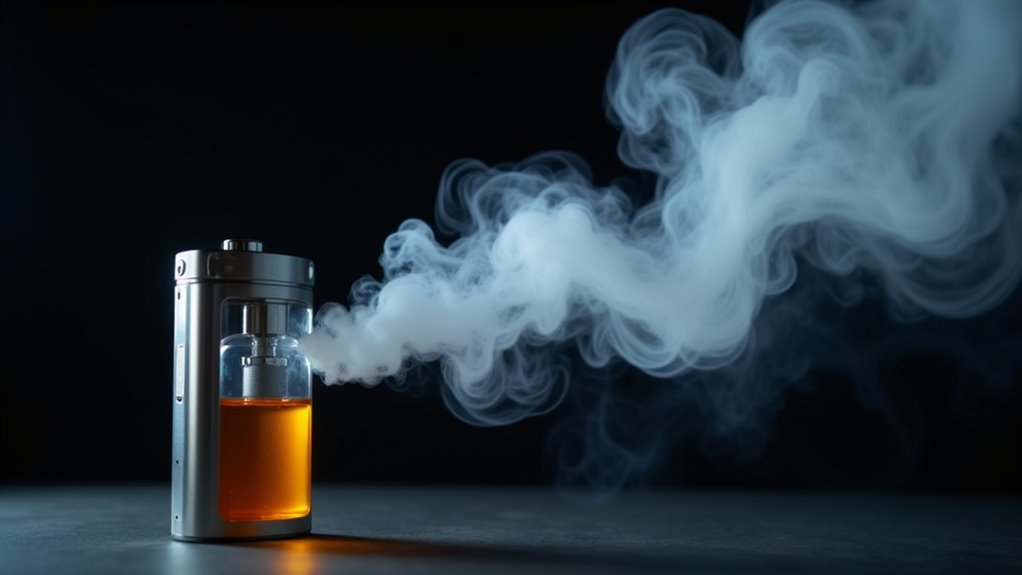Vaping’s intense addictiveness stems from nicotine’s rapid hijacking of your brain’s reward system. When you vape, nicotine reaches your brain in just 7-10 seconds, triggering a flood of dopamine while suppressing MAO enzymes that would normally break it down. Your brain quickly develops more nicotine receptors, requiring increasingly higher doses to achieve the same effect. This creates a powerful cycle of dependency, especially in teenagers whose developing brains are particularly vulnerable. Understanding these neurochemical changes reveals the full scope of vaping’s grip.
The Science Behind Nicotine’s Grip

When nicotine enters your bloodstream through vaping, it rapidly crosses the blood-brain barrier and binds to specialized nicotinic acetylcholine receptors (nAChRs) throughout the brain. This binding triggers a cascade of nicotine’s neurochemical effects, primarily targeting α4β2 and α7 receptor subtypes in addiction-related regions.
Your brain’s reward system responds with a surge of dopamine while nicotine simultaneously suppresses MAO enzymes, prolonging dopamine’s effects. With continued use, long-term brain changes develop as receptors become less sensitive, requiring more nicotine to achieve the same effect. You’ll experience altered neurotransmitter systems beyond dopamine including GABA, glutamate, and serotonin. This complex interplay creates a powerful cycle of dependence, as your brain adapts to function with nicotine present while becoming increasingly resistant to its effects. The negative reward process helps explain why people find quitting so difficult, as stopping nicotine use can trigger intense feelings of anxiety and irritability.
How Vaping Hijacks Your Brain’s Reward System
Anyone who’s vaped knows the powerful pull it has on behavior, but the mechanism behind this attraction lies in nicotine’s sophisticated hijacking of your brain’s reward system. When you vape, nicotine mimics acetylcholine, triggering an intense dopamine release that fundamentally alters your neural pathways. This alteration is especially concerning since brain development continues until the mid-twenties. A single vaping pod contains nicotine levels that can deliver 20 cigarettes’ worth of the addictive substance. The pleasurable effects are intensified because nicotine creates a lasting glutamate-GABA imbalance in the brain.
| Brain Region | Normal Function | Nicotine’s Impact |
|---|---|---|
| VTA | Regulates pleasure | Overactivates dopamine |
| NAc | Processes rewards | Intensifies cravings |
| Prefrontal Cortex | Controls impulses | Weakens resistance |
| Amygdala | Manages stress | Increases anxiety |
These long term brain changes create a vicious cycle where nicotine withdrawal symptoms drive continued use. Your brain’s reward circuitry becomes rewired, making natural pleasures less satisfying while amplifying the perceived benefits of vaping. Environmental triggers further strengthen this addictive loop, making cessation increasingly challenging.
Why Teens Are More Susceptible to Addiction

While nicotine addiction affects users of all stages, teenagers face heightened vulnerability due to their developing brains and unique social pressures. During adolescence, cognitive development impacts are more severe, as nicotine interferes with critical brain formation and neural pathway establishment. Studies show that group counseling support has proven most effective in helping teens quit.
You’ll find that adolescent brain vulnerabilities make teens particularly susceptible to addiction, with higher nicotine absorption rates than adults. Young people between ages 15-17 are 16 times more likely to vape than adults aged 25-34. The allure of fruit and candy flavors makes these products especially appealing to young users.
The statistics paint a concerning picture: one in six high school students report daily nicotine use, with over 620,000 teens showing dependence through regular vaping. Portable devices and peer acceptance create a perfect storm for addiction formation.
When you combine these factors with teenagers’ biological susceptibility and the widespread availability of high-nicotine products, you’ll understand why early exposure often leads to sustained nicotine dependence well into adulthood.
Breaking Down the Vaping Habit Loop
When you vape, dopamine floods your brain’s reward system, creating powerful feedback loops that make the habit increasingly difficult to break.
Your brain quickly learns to associate specific triggers (like stress, locations, or social situations) with the dopamine rush from vaping, establishing automatic behavioral patterns that feel natural and necessary. This temporary relief becomes a dangerous cycle as stress triggers cravings, leading to more frequent vaping sessions.
Understanding these trigger-reward connections is essential for dismantling the habit loop, as you’ll need to consciously redirect your responses in the direction of healthier alternatives. This chemical dependency makes nicotine particularly challenging to quit as it hijacks logical thinking, causing cravings to override rational decisions about health. The speed at which nicotine affects the brain is remarkable, taking just 7-10 seconds to reach the frontal lobe after inhaling.
Dopamine’s Powerful Grip
The powerful dopamine cascade triggered by vaping creates one of the most tenacious addiction cycles in modern substance use. When you vape, nicotine’s neurotransmitter interplay immediately activates nicotinic acetylcholine receptors, forcing your brain to release floods of dopamine into the nucleus accumbens. This dopamine reward system implication fundamentally alters your brain’s chemistry. This perceived pleasure is actually part of a vicious cycle where users experience short-term relief followed by withdrawal symptoms. Similar to how pharmacogenomic data influences drug responses, genetic variations can affect individual susceptibility to nicotine addiction.
Your neurons respond by increasing receptor density, requiring more nicotine to achieve the same delightful effect. Meanwhile, nicotine suppresses your monoamine oxidase enzymes, allowing dopamine to linger longer in your system. This double impact augmented release and delayed breakdown creates an intensely reinforcing cycle. Your brain’s reward pathways become rewired, making natural pleasures seem dull in comparison while strengthening the grip of nicotine dependency. Studies show that nearly 70 percent of adults who regularly use nicotine products want to break free from this addictive cycle.
Breaking Trigger-Reward Patterns
Breaking free from nicotine’s dopamine manipulation requires understanding how vaping habits become deeply embedded behavioral patterns. Your brain has established automatic connections between triggers, cues, and the reward of vaping through repeated cycles of behavior.
To disrupt this pattern, you’ll need to focus on habit reinvention and environmental desensitization. Time-based cues can help you establish structured intervals for managing cravings throughout the day. Start by identifying your specific triggers whether they’re stress, social situations, or daily routines. Then, systematically replace vaping with healthier alternatives like chewing gum or breathing exercises. Without a natural stopping point like a burning filter, vaping can lead to hundreds of unconscious puffs throughout the day.
Remove vaping devices and related items from your environment to reduce unconscious cues. Practice mindfulness during cravings to observe your emotions without acting on them. These interventions help rewire your brain’s reward pathways, weakening the automatic response to vape when triggered.
Physical and Mental Health Impacts

Research demonstrates that vaping’s physical and mental health impacts extend far beyond basic nicotine addiction. The exposure to unknown chemical compounds and aerosols creates considerable long-term lung damage risks that medical experts are still working to fully understand.
Your cardiovascular system faces immediate strain as nicotine triggers increased blood pressure, heart rate spikes, and potential arrhythmias that can lead to serious cardiac events.
Your respiratory system endures both acute and chronic damage, with conditions like EVALI causing severe inflammation and breathing difficulties.
Your brain chemistry alters greatly, as nicotine addiction pathways mirror those of cocaine and heroin, making cessation extremely challenging.
Your mental health becomes vulnerable to heightened anxiety, depression, and sleep disruptions, particularly during withdrawal periods when dopamine levels fluctuate dramatically.
Social Pressures and Environmental Factors
The social dynamics around vaping extensively increase your likelihood of developing nicotine addiction, with research showing you’re over five times more likely to vape if your close connections do.
You’ll find that peer pressure intensifies in social settings where vaping is normalized, particularly through social media platforms where 70% of teens encounter e-cigarette advertising.
Your susceptibility to vaping addiction strengthens through constant exposure to influencer content, targeted marketing, and the perception of vaping as a standard social activity within your peer networks.
Peer Influence Drives Usage
Countless adolescents face mounting social pressure to vape, with over 1.6 million U.S. youth currently using e-cigarettes amid pervasive peer networks. Research shows that group norms and peer facilitation profoundly influence vaping initiation and continued use, particularly in school environments where social dynamics intensify the pressure to conform.
You’re more likely to start vaping if your best friends use e-cigarettes, as peer approval drives curiosity and experimentation. School settings serve as primary hubs for device distribution and social reinforcement. Your exposure to vaping increases through “vaping circles” and peer-operated networks. You’ll find social media amplifies these influences, with platform algorithms promoting pro-vaping content within teen networks.
These peer pressures create a cycle where social acceptance and group belonging become intertwined with vaping behaviors.
Social Settings Enable Addiction
Social environments markedly amplify nicotine addiction through multiple reinforcing mechanisms that normalize vaping behaviors. When you’re surrounded by family members or peers who vape, you’ll face increased exposure and accessibility to e-cigarettes, making cessation more challenging.
Your local community’s retail milieu, particularly the proximity of vape shops and convenience stores, can enable frequent purchasing patterns that sustain addiction.
Media messaging and cultural influences further complicate your relationship with vaping. You’ll encounter social media content and marketing that downplays health risks while promoting e-cigarettes as socially acceptable.
To address these challenges, community intervention programs and targeted policy reforms must focus on restricting retail access, strengthening verification of age, and countering misleading promotional content that perpetuates addiction cycles.
Warning Signs of Nicotine Dependence
Recognizing nicotine dependence early can help prevent severe addiction and its associated health complications. You’ll notice distinct withdrawal timelines and dependence indicators that signal your body’s reliance on nicotine.
Physical symptoms emerge within hours of your last use, including anxiety, panic attacks, and increased appetite, peaking during the primary week and typically subsiding within 2-4 weeks
Withdrawal from nicotine hits fast and hard, triggering anxiety and intense cravings before gradually easing over several weeks.
Behavioral changes manifest through failed quit attempts and using larger amounts than intended, with 13% of U.S. adults showing monthly usage patterns
You’ll experience cognitive impairment affecting work performance, accompanied by persistent restlessness and preoccupation with obtaining nicotine
Emotional signs include heightened irritability, mood swings, and augmented stress levels when cravings aren’t met, often leading to social withdrawal and denial of addiction despite clear evidence
Breaking Free: Recovery Pathways
Breaking the cycle of nicotine dependence requires an exhaustive treatment approach backed by evidence-based strategies. Research shows you’ll have the highest chance of success by combining nicotine replacement therapy (NRT) with behavioral interventions like cognitive-behavioral therapy or counseling. These evidence-based recovery methods can double your likelihood of achieving sustained abstinence.
Your path to freedom starts with customized intervention plans that address your specific triggers, lifestyle, and concurrent substance use challenges. You’ll need to navigate through peak relapse risks in the initial month, but structured support systems can help you maintain momentum. Whether it’s through group programs, motivational interviewing, or tech-enabled coaching, today’s extensive treatment approaches offer proven pathways to overcome nicotine’s powerful grip and achieve long-term recovery success.
Resources and Support Systems
Extensive support resources have emerged to help individuals overcome vaping addiction, with text-based programs showing particular promise. Programs like “This is Quitting” have demonstrated a 40% increase in quit rates among young adults, offering anonymous, stigma-free assistance regardless of socioeconomic factors.
Text-based programs provide accessible support across demographics, maintaining consistent success rates regardless of nicotine dependence or mental health status.
Private insurance coverage substantially improves quit success rates to 9.4%, while limited access affects lower-income individuals.
Clinical trials validate the effectiveness of structured behavioral interventions, particularly when combined with pharmaceutical approaches.
Anonymous digital support reduces barriers to entry, allowing you to seek help confidentially while accessing evidence-based strategies for managing withdrawal symptoms.
Frequently Asked Questions
Can Second-Hand Vapor From E-Cigarettes Cause Nicotine Addiction in Others?
While secondhand vapor exposure can contain nicotine, research shows it’s unlikely to cause addiction in bystanders. Studies indicate passive vaping risks are considerably lower than secondhand smoke, with 83.6% less nicotine absorption. You’ll find that exposure levels from secondhand vapor are typically too low to trigger nicotine dependence.
However, it’s still crucial to minimize exposure, especially for children, as vapor isn’t completely risk-free.
How Long Does It Typically Take for Nicotine Cravings to Stop Completely?
Your nicotine withdrawal timeline typically spans several weeks, with the most intense cravings occurring in the initial 72 hours after quitting.
While physical symptoms peak within 3-5 days, you’ll likely experience cravings for 2-4 weeks. Managing nicotine cravings becomes easier after the opening month, though some people report occasional urges for several months. With proper support and coping strategies, you’ll find these cravings become less frequent and more manageable over time.
Do Different Vape Juice Flavors Contain Varying Levels of Addictive Substances?
No, vape juice flavorings don’t affect the nicotine concentration levels in your e-liquid. The addictive substance (nicotine) is standardized and remains consistent regardless of whether you choose fruit, menthol, or dessert flavors.
While manufacturers offer different nicotine strengths (like 3mg, 6mg, or 12mg), these variations are independent of flavor choices. Don’t let marketing tactics mislead you a flavor’s sweetness or intensity doesn’t indicate higher or lower addiction potential.
Can Prescription Medications Help Reduce Vaping Addiction and Withdrawal Symptoms?
Yes, prescription medications can effectively help you overcome vaping addiction and manage withdrawal symptoms. Varenicline (Chantix) shows the highest success rates, reducing cravings by blocking nicotine receptors.
You can combine this with nicotine replacement therapy to ease physical withdrawal symptoms. For the best results, you’ll want to pair medications with behavioral counseling, which helps address psychological dependence.
Bupropion is another option that can help stabilize your mood during withdrawal.
Does Genetics Play a Role in How Easily Someone Becomes Addicted to Vaping?
Yes, your genetic makeup considerably influences your susceptibility to vaping addiction. Research shows that 40-70% of nicotine dependence risk is inherited.
Your genetic predisposition can affect how your brain responds to nicotine and may intersect with underlying mental health conditions. If you have family members with addiction histories or risk-taking behaviors, you’re more likely to develop a vaping dependency.
This genetic vulnerability becomes particularly significant when combined with environmental triggers.










